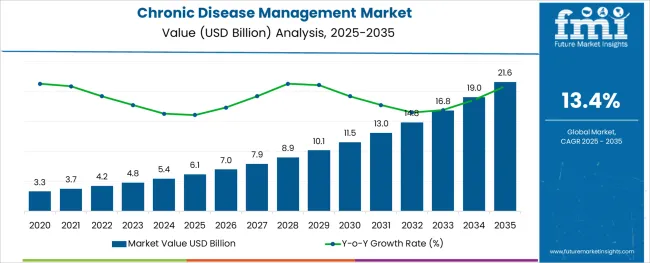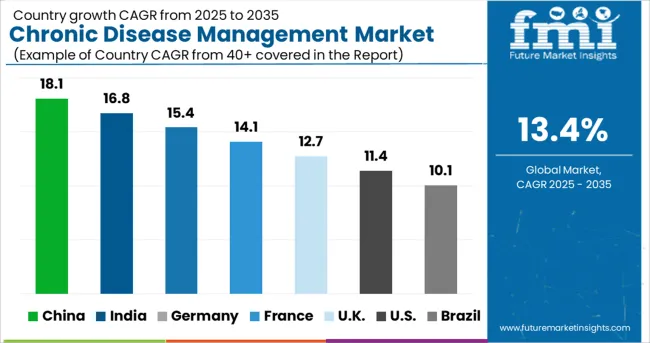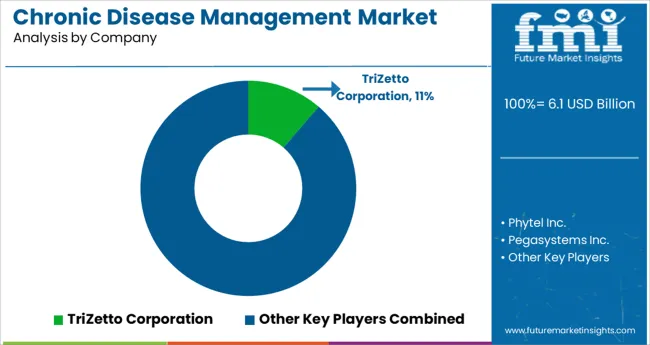The Chronic Disease Management Market is estimated to be valued at USD 6.1 billion in 2025 and is projected to reach USD 21.6 billion by 2035, registering a compound annual growth rate (CAGR) of 13.4% over the forecast period.

The chronic disease management market is undergoing substantial transformation fueled by the global rise in lifestyle-related disorders, aging populations, and policy shifts favoring value-based care models. A growing focus on preventive healthcare, continuous monitoring, and early intervention is increasing demand for structured chronic care programs. Providers and payers are prioritizing integrated care solutions that combine data analytics, telehealth, and patient engagement tools to improve health outcomes while reducing long-term costs.
Digitally connected care ecosystems are being deployed to manage diseases such as diabetes, cardiovascular conditions, and respiratory illnesses. Governments and insurers are supporting these developments through reimbursement incentives and national digital health frameworks.
At the same time, scalability through cloud-based platforms and customizable consulting support is helping health systems align with population health strategies. Future growth is expected to accelerate as interoperability, remote patient monitoring, and AI-driven clinical decision support become standard features of chronic care delivery.
The market is segmented by Service Type, Delivery Mode, and End User and region. By Service Type, the market is divided into Consulting Services, Implementation Services, Educational Services, and Other. In terms of Delivery Mode, the market is classified into Cloud-based, On-premise, and Web-based. Based on End User, the market is segmented into Providers and Payers. Regionally, the market is classified into North America, Latin America, Western Europe, Eastern Europe, Balkan & Baltic Countries, Russia & Belarus, Central Asia, East Asia, South Asia & Pacific, and the Middle East & Africa.

Consulting services are expected to account for 33.7% of the chronic disease management market revenue by 2025 within the service type category. This share leadership is being driven by the increasing need among healthcare organizations to design, implement, and optimize personalized chronic care programs.
Consultants are playing a key role in aligning clinical workflows, population health analytics, reimbursement models, and regulatory compliance across fragmented healthcare infrastructures. As digital health tools become more sophisticated, expert advisory services are helping providers select interoperable solutions and drive measurable outcomes.
In addition, strategic guidance on telehealth integration, value-based contracting, and patient engagement strategies has further solidified demand. The ability of consulting firms to support organizational transformation while delivering patient-centered innovation is a primary factor contributing to the continued expansion of this segment.

The cloud-based delivery mode is projected to hold 39.6% of market revenue in 2025, leading among delivery models for chronic disease management. This leadership is attributed to its ability to enable real-time data exchange, seamless scalability, and remote accessibility, which are critical in managing long-term health conditions.
Cloud platforms support centralized data repositories, interoperability with electronic health records, and continuous remote patient monitoring, making them ideal for coordinated chronic care. Providers and payers are favoring cloud-based systems for their lower upfront investment, reduced infrastructure burden, and simplified software updates.
These platforms also facilitate the integration of AI-powered analytics, predictive modeling, and personalized alerts, enhancing clinical decision-making and patient adherence. As demand grows for decentralized and digitally driven care models, cloud-based solutions are positioned to remain the backbone of chronic disease management infrastructure.

The providers segment is anticipated to command 62.4% of total revenue in the chronic disease management market by 2025, making it the most dominant end user category. This position is being reinforced by hospitals, clinics, and care networks increasingly adopting chronic care platforms to manage rising patient volumes and improve care continuity.
Providers are utilizing integrated solutions that combine real-time monitoring, teleconsultation, medication tracking, and personalized interventions to address the complexity of chronic illness management. The growing emphasis on reducing hospital readmissions, meeting quality benchmarks, and aligning with reimbursement frameworks is further encouraging technology adoption.
Investment in digital health infrastructure by provider groups has also supported the expansion of care beyond clinical settings into homes and communities. The ongoing push toward accountable care, bundled payments, and data-driven population health strategies continues to strengthen the role of providers as the primary drivers of chronic disease management innovation.
The chronic disease management market size is projected to expand to a significant extent over the forecast period due to increasing awareness of people to avail of these services. In addition, there is huge competition among the leading providers in this market.
Both leading and local service provider offers various scheme to compete in the market. Further, chronic disease management service is gaining traction due to the use of health information technologies and improved availability of online resources in healthcare.
The increasing prevalence of chronic diseases such as asthma, COPD, cancer, diabetes, stroke, or musculoskeletal diseases around the globe is the key factor driving the growth of the chronic disease management market. Besides that, increasing awareness regarding healthcare management has also upsurged the demand for chronic disease management over the forecast period.
Improved services by service providers have increased the demand for chronic disease management in the market. Further, the growth in the medical tourism sector and the rise in healthcare IT solutions have fueled the progression of chronic disease management market trends and forecasts.
High investment required to establish the infrastructure and data security concerns related to cloud-based solutions can also hamper the progress of the chronic disease management market. Moreover, inadequate patient engagement and lack of interoperability are responsible for the sluggish growth of this market.

| Country | Revenue Share % (2025) |
|---|---|
| The United States | 38.4% |
| Germany | 5.9% |
| Japan | 3.8% |
| North America | 44.1% |
| Europe | 29.7% |
| Country | CAGR % (2025 to 2035) |
|---|---|
| China | 19.4% |
| India | 15.9% |
| Australia | 14.1% |
North America is expected to be an attractive market for chronic disease management due to the availability of advanced healthcare infrastructure in the United States. In addition, the increasing geriatric population in North America is fueling the growth of chronic disease management in the region. Health insurance policies are also contributing to the growth of the market. Thus, due to the aforementioned reasons, North America held a 44.1% market share for the chronic disease management market in 2025.
Many countries in Europe are affected by cardiovascular diseases. This is leading to people gaining problems with diabetes and obesity. Moreover, cardiovascular diseases are also a key reason for increasing death in the region. This has led to people investing in health insurance policies to manage illnesses better.
Quick and efficient reimbursement facilities are positively influencing the growth of the market in the region. Thus, owing to the reasons mentioned above, Europe held a 29.7% chronic disease management market share in 2025.
| Category | By Delivery Type |
|---|---|
| Leading Segment | On-premise |
| Market Share (2025) | 54.3% |
| Category | By End User Type |
|---|---|
| Leading Segment | Providers |
| Market Share (2025) | 58.8% |
Key start-ups for chronic disease management are Care Clinic, EveryDose, Pathmate, TheBigPicture, and Phable.
It tracks 12 primary human systems, including organs, tissues, and cellular biometrics to assist users in tracking, organizing, maintaining, and improving their health. It includes features like personalized food programs to monitor health indicators and prevent chronic diseases.
Leading service providers in this market are focusing on collaboration and partnership with healthcare stakeholders to provide patient-centric care, in turn bringing about emerging trends in the chronic disease management market. For instance:

The global chronic disease management market is estimated to be valued at USD 6.1 billion in 2025.
It is projected to reach USD 21.6 billion by 2035.
The market is expected to grow at a 13.4% CAGR between 2025 and 2035.
The key product types are consulting services, implementation services, educational services and other.
cloud-based segment is expected to dominate with a 39.6% industry share in 2025.






Full Research Suite comprises of:
Market outlook & trends analysis
Interviews & case studies
Strategic recommendations
Vendor profiles & capabilities analysis
5-year forecasts
8 regions and 60+ country-level data splits
Market segment data splits
12 months of continuous data updates
DELIVERED AS:
PDF EXCEL ONLINE
Chronic Granulomatous Disease (CGD) Management Market – Size, Share & Trends 2025 to 2035
Chronic Sarcoidosis Therapeutics Market Size and Share Forecast Outlook 2025 to 2035
Chronic Phase Markers Market Size and Share Forecast Outlook 2025 to 2035
Chronic Venous Occlusions Treatment Market Size and Share Forecast Outlook 2025 to 2035
Chronic Lymphocytic Leukemia Therapeutics Market Size and Share Forecast Outlook 2025 to 2035
Chronic Lymphocytic Leukemia Market Size and Share Forecast Outlook 2025 to 2035
Chronic Dryness Repair Market Analysis - Size and Share Forecast Outlook 2025 to 2035
Chronic Skin Redness Care Market Size and Share Forecast Outlook 2025 to 2035
Chronic immune thrombocytopenia treatment Market Size and Share Forecast Outlook 2025 to 2035
Chronic Hepatitis B Virus Testing Market Size and Share Forecast Outlook 2025 to 2035
The Chronic Wound Care Market is segmented by product, wound type and distribution channel from 2025 to 2035
Chronic Pulmonary Hypertension Treatment Market Analysis and Forecast by Drug Type, Route of Administration, Distribution Channel, Region through 2035
Chronic Smell and Flavor Loss Treatment Market – Innovations & Growth 2025 to 2035
Chronic Refractory Cough Treatment Market – Growth & Innovations 2025 to 2035
Chronic Pain Market Analysis – Growth, Demand & Forecast 2024 to 2034
Chronic Brain Damage Treatment: Trends, Growth, and Key Developments
Chronic Respiratory Diseases Treatment Market
Chronic Obstructive Pulmonary Disease (COPD) Market Trends – Growth & Forecast 2023-2033
Late Stage Chronic Kidney Disease Therapeutics Market Size and Share Forecast Outlook 2025 to 2035
Disease Resistant Mask Market Analysis - By Type, Material, End-User, Distribution Channel, and Region - Trends, Growth & Forecast 2025 to 2035

Thank you!
You will receive an email from our Business Development Manager. Please be sure to check your SPAM/JUNK folder too.
Chat With
MaRIA